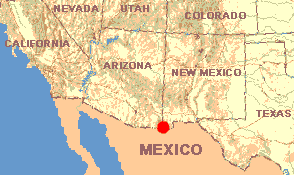 March 4,
1988
March 4,
1988NEW MEXICO: Hidalgo County
Coronado National Forest three miles east of the Arizona border and fifteen miles north of the Mexican border, in the Peloncillo Mountains. Elevation between 6000 and 7000 feet.
 March 4,
1988
March 4,
1988An official National Forest trail has been established down the road. Today I go see where it leads.
7:20 AM. 28°, sunlight barely hitting the ridge tops, white frost on dark-green Emory Oak leaves, streambed pools of water thinly incrusted with transparent abstractions of elongated, randomly juxtaposed ice crystals.
7:40. Find upper section of a Raccoon's skull.
7:45. Our sixth new species of cactus, but I pass it by, not wanting to get over-cactused
8:10. The trail climbs onto a sunny, southeast-facing slope where the temperature already is 52°. While I rest beside a dead Palmer Agave bearing a seventeen-foot flower stalk, a pair of Bridled Titmice come fussing among the agave's old fruit-pods. Northerners accustomed to mouse-colored Tufted Titmice and Plain Titmice can be surprised seeing this species' harlequin-mask face design.
8:40. The trail is so seldom used that in most
places it simply doesn't exist. I find the way by following stacks of rocks, or cairns.
After about two miles the cairns lead into an extremely rough canyon overgrown with thorny
bushes, and then the cairns simply disappear. For half an hour I circle, looking for the
trail, often being fooled by wildlife paths that start off plain as day, then melt into
trackless scrub. Eventually it becomes clear that someone has switched the cairns around,
leaving false ones leading into this miserable little canyon. For half an hour I sit
fuming about the disintegration of society and the universal law of nature causing the
creative process to be so difficult, and acts of destruction to be so
easy. Now I'll simply navigate cross-country, using the true and trusted sun to keep my
bearings.
l0:00. In a rock-bedded stream of the type that in Kentucky would supply several salamanders representing two or three species, for half an hour I turn over rocks but find no salamanders. I'm so astonished by this failure that in my Audubon Society's Field Guide to North American Reptiles and Amphibians I consult the distribution maps of each of the 112 salamander species occurring north of Mexico. I find that only the Tiger Salamander possibly can be found here, and it's to be expected especially at night after heavy rain.
11:30. Neither are ferns very conspicuous in the southwestern desert. However, fairly common in rock cracks along this particular deeply entrenched stream is the Fendler's Lipfern, Cheilanthes fendleri. It's a strange fern with spores originating beneath turned-under leaflet margins, not from standard sori or fruit-dots scattered across a frond's lower surface.
11:45. Wanting to see some reptiles, with the temperature at 62° in the shade, I find an exposed rocky cliff in full sunlight, sit on the slope opposite it, and begin watching for lizards and snakes. In Kentucky, in such a place and on such a warm, early-spring morning, I'd surely see Fence lizards and maybe a Copperhead snake or two.
NOON. Waiting for reptiles I hear an unfamiliar birdcall. With the tone quality of a mourning dove's call, it consists of three to six hoo sounds, with the last hoos trailing off softly and descending in pitch. The call is easy to imitate so I begin alternating hoo-hoos with my invisible companion. A certain urgency creeps into his calls, and I try to mimic this urgency, mostly by calling louder and faster. After five minutes of this he stops calling altogether, but a minute later he begins again, this time from a much closer position. Moreover, I think I see him about thirty feet away, atop a rock, almost hidden by bushes. With my binoculars I discover one of the very symbols of the Southwest, the Greater Roadrunner, a member of the Cuckoo Family. While calling, this bird rests his long beak on his chest, and with each hoo his chest heaves and his head nods downward. The appearance is of an invisible hand using his head like a pump handle, pumping hoos from his chest. After each series of hoos he cocks his head to one side, apparently listening for my response. We exchange hoo-hoos for about twenty more minutes. Then he seems to lose interest, and so do I.
1:00 PM. Still no reptiles.
1:20. During the walk back to Henry a Gray fox's skull is found